Various types of black monkeys exist around the world. From howler black monkeys heard up to 3 miles away to macaques, various species are dominated by a black appearance.
Found in the forest, most of these black monkeys live on trees. Some may leap to other trees while others come down to move within the canopy.
Here are some of the most unique types of black monkeys and what makes them stand out.
Table of Contents
1. Mantled Howler Monkey
From dry forests to rainforests, Mantled Howler Monkeys (Alouatta palliata) are found in a series of terrains from Costa Rica to Peru.
They are born black and remain almost completely black as adults.
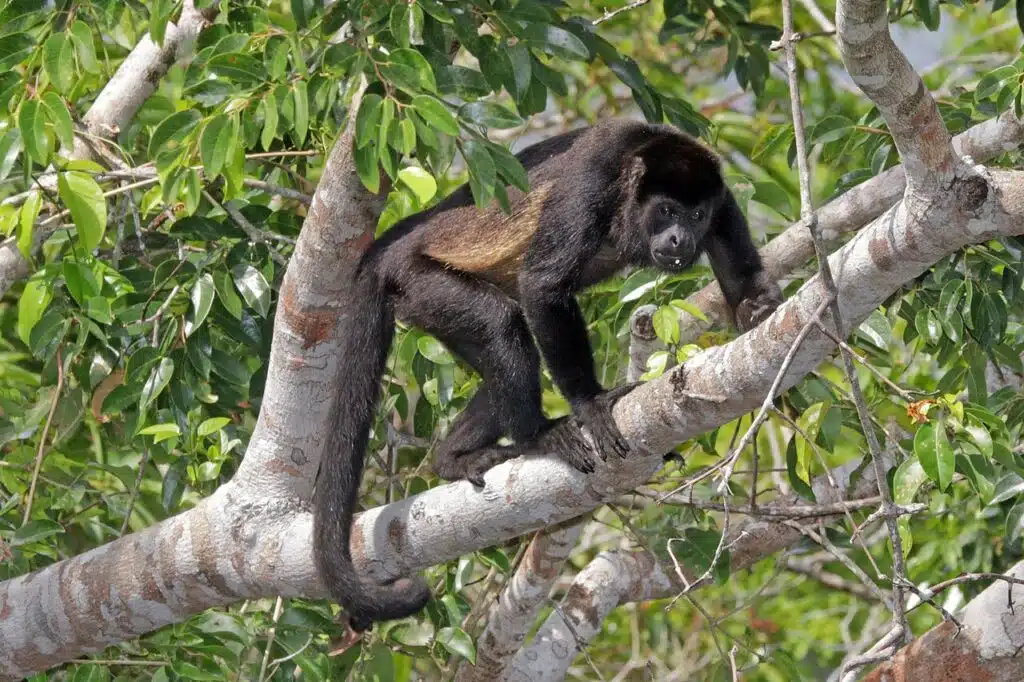
Males may be the exception as their genitalia turn white when they reach breeding age.
These monkeys have large jaws and strong adapted teeth they use to chew leaves.
While they don’t eat all day, they may sometimes be spotted up on trees, including on those next to beaches resting or eating.
This species additionally shows a hairless black skin face color which makes them resemble gorillas.
Mantled Howler Monkeys live in small groups under a leading male. Aggression within the group itself is rare to non-existent.
2. Yucatán Black Howler Monkey
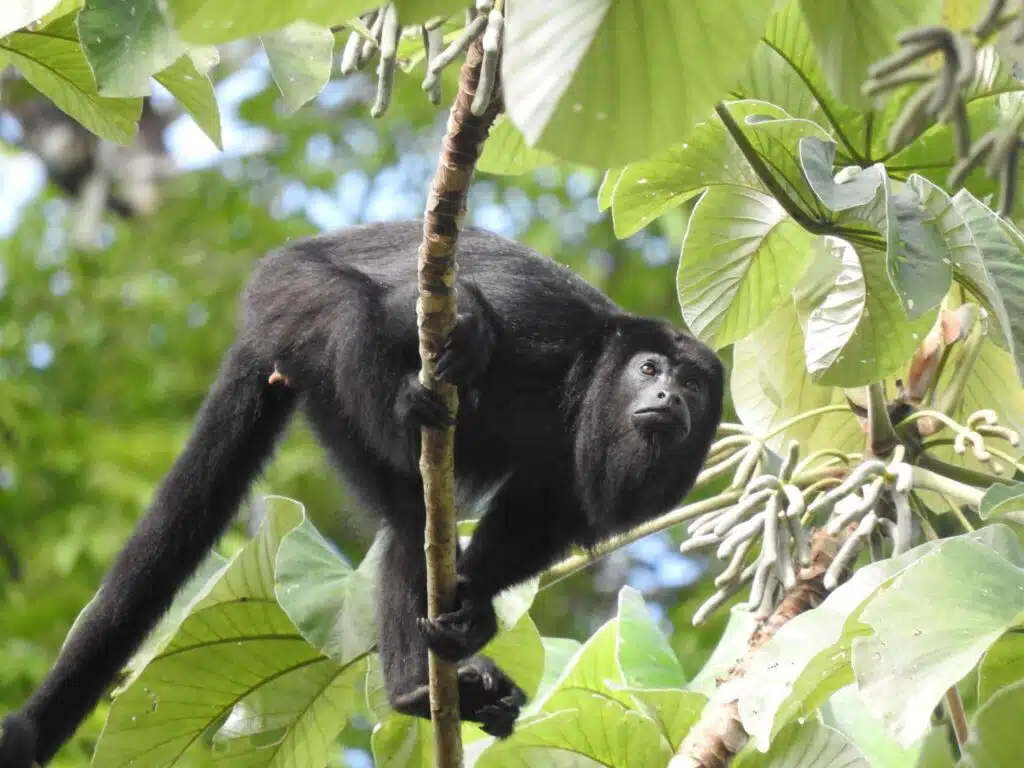
A species of Central America, this type of black monkey (Alouatta pigra) is named after its endemic Yucatan Peninsula.
Mostly feeding on leaves and fruit, these types of monkeys live in very small groups, with a few possible exceptions.
Groups of just 2-3 monkeys are possible. Both males and females are black but females tend to be more numerous in groups of up to 10.
Female Yucatan Black Howler Monkeys mostly remain in the same group they are born in.
Males take up to 6 years to mature sexually and typically live in their native groups at this time.
These black monkeys are mostly spotted feeding, as this is their primary daily activity.
They can even feed upside down, hanging off branches by their long black tails which may be as long as the body itself.
3. Black Capuchin
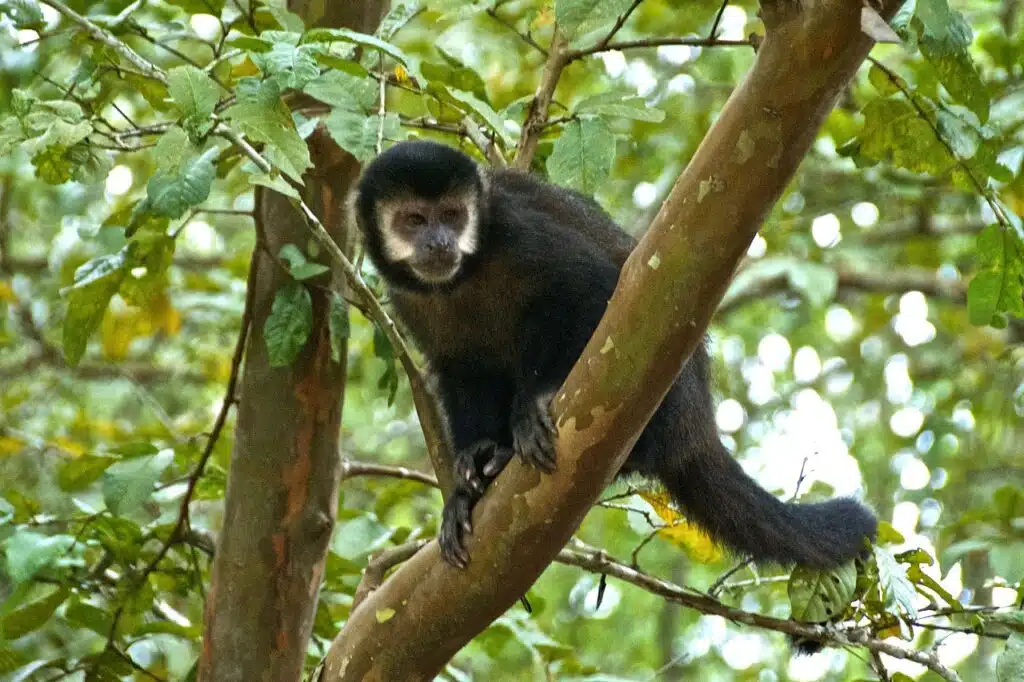
Mostly black and just partly brown, Black Capuchins (Sapajus nigritus) are among the South American species also found in parts of Argentina, apart from most common territories of Brazil.
As true omnivores, these types of monkeys are seen moving around trees for food. Their black chests, legs, and hands are the most visible.
Black Capuchins show atypical aggression between members of either the same group or of other groups.
Males are the most likely to show aggression even towards the juveniles of other species, particularly when trying to infiltrate a group.
They may even kill all juveniles in an effort to control the offspring and breed their own juveniles.
Even females show this aggression, especially when controlling the offspring and breeding rights of other females in a group.
4. Dusky Leaf Monkey
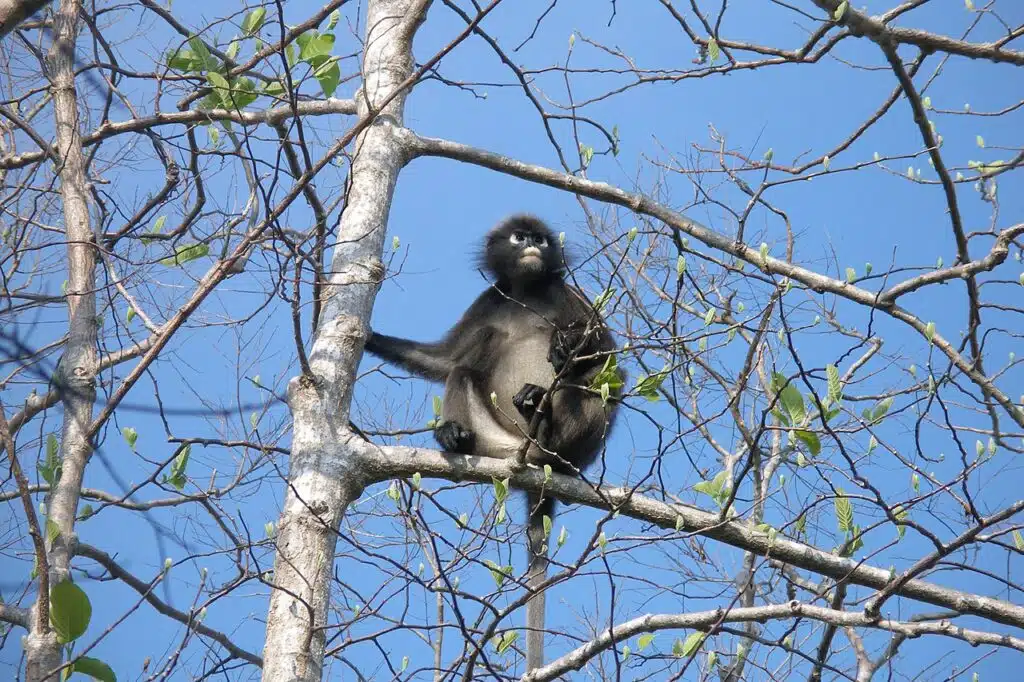
The Dusky Leaf Monkey (Trachypithecus obscurus) is sometimes black. It can also have a dusky nuance or various types of darker gray nuances while its mouth and region around its eyes are almost white.
Mostly black and sometimes white on the head and around the hands and legs, these types of monkeys are born brighter.
They have a bright orange appearance as juveniles and show different levels of darkening as they age and become ready to breed.
Dusky Leaf Monkeys are among the first to become ready to breed among all monkeys, some as soon as 3 years old.
These types of monkeys have an easier time raising their offspring as they can spot them due to their orange colors.
Females are more likely to take care of the young as males rarely assist.
The female Dusky Leaf Monkey is also responsible for teaching the young how to eat leaves by chewing the leaves for them at first.
5. Black-and-gold Howler Monkey
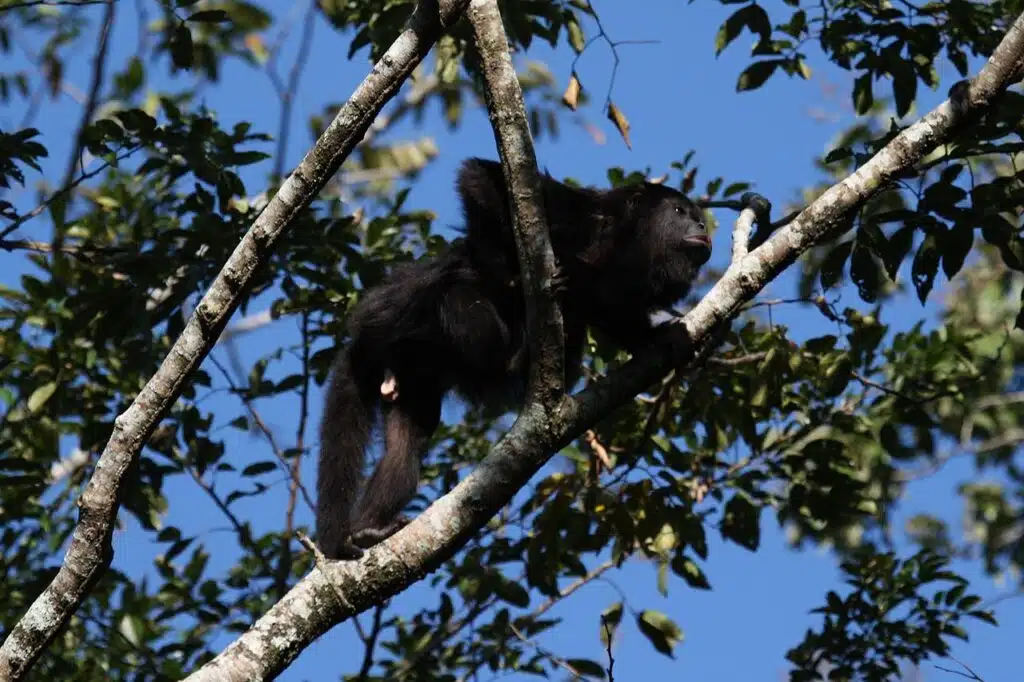
Endemic to Southern Brazil, The Black-and-gold Howler Monkey (Alouatta caraya) shows at least some degree of color variation.
Males are the black ones while females have a bright and slightly golden appearance.
As their name implies, these monkeys are loud vocalizations. Heard even at distances of several miles, these vocalizations are the result of an enlarged mouth and jaw.
The monkeys howl for others to hear them and to stay away.
However, while the call is loud, it’s believed these monkeys have a smaller jaw compared to other howling monkeys also endemic to South America.
A long-living species, these monkeys may survive up to 20 years.
6. Black-mantled Tamarin
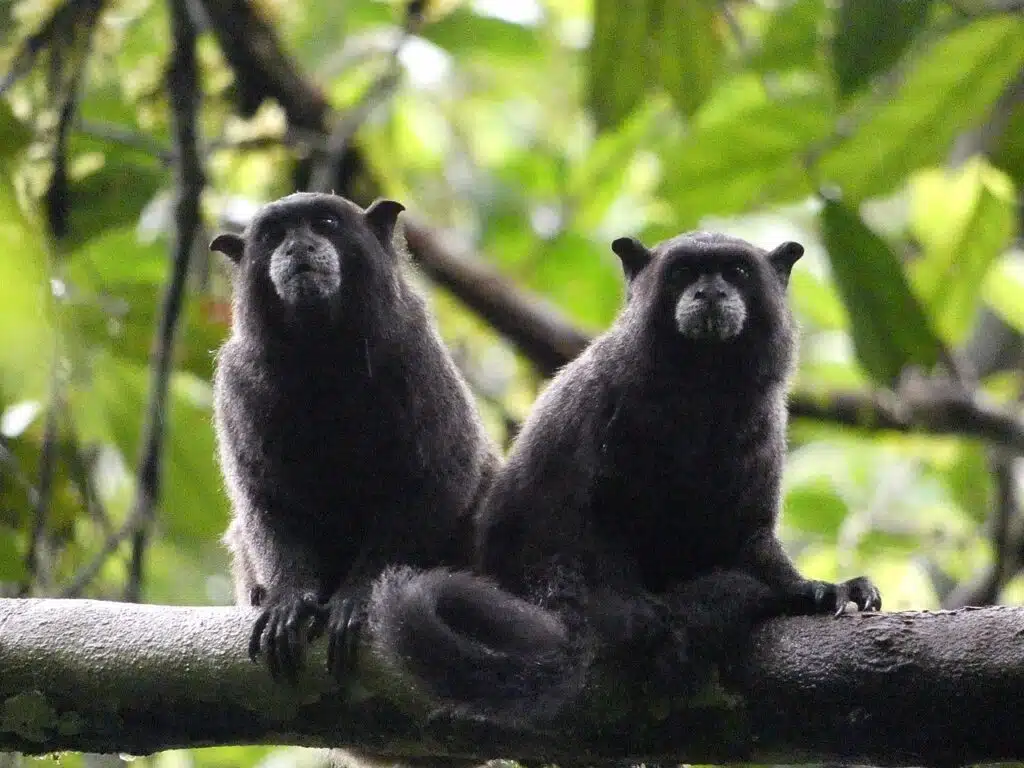
Small monkeys of this genus are known to have an almost completely black appearance.
Black-mantled Tamarins (Saguinus nigricollis) are among the monkeys with a mixed diet, mostly eating insects, followed by plants, and fruit.
These small black monkeys live more than 10 years with an average of almost 14 years in the wilderness where they organize in groups.
They even sleep together next to each other for extra protection during the night.
Communal living is also seen in other shared aspects of their lives such as sharing offspring care duties. Multiple group members provide for the offspring.
Monkeys of this species are also important prey for other types of predators in the rainforest.
7. Purple-faced Lutung
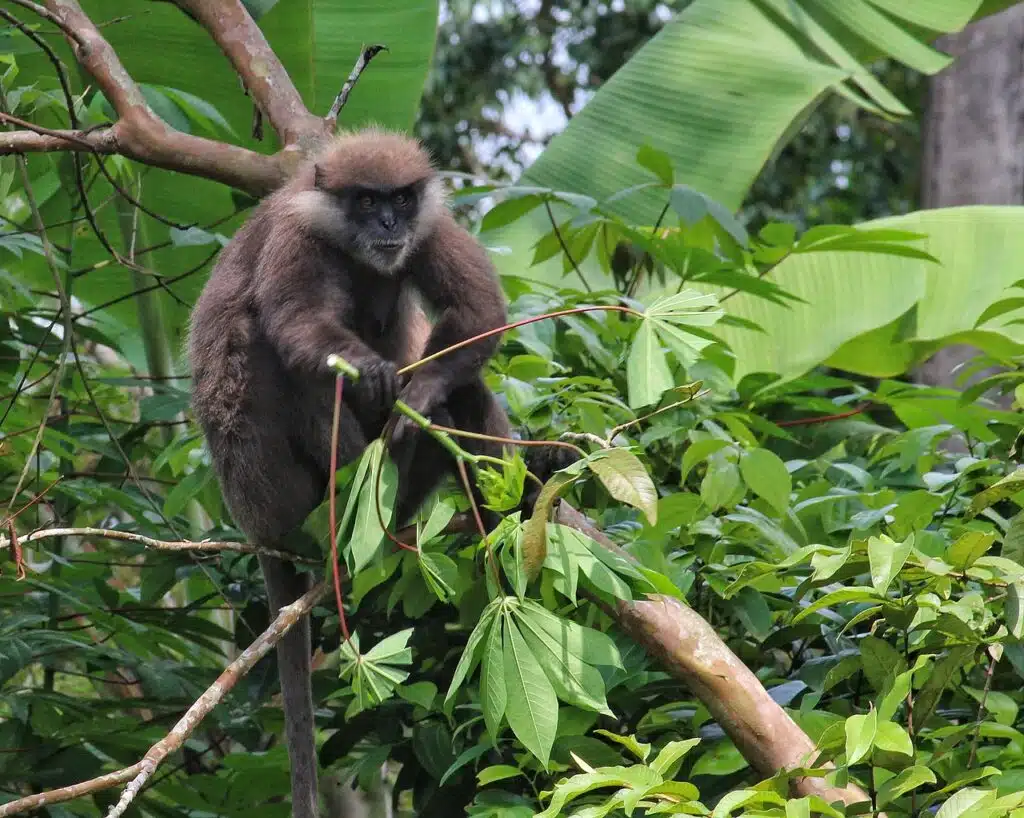
Purple-faced Lutungs (Semnopithecus vetulus) don’t actually have purple faces but black or brown faces.
Mostly black once they become adults, these monkeys live in Southern Sri Lanka. This is known as the wet area of the country due to its humid forests.
The monkeys of this family live in groups, showing diurnal activity.
A typical group numbers 1-2 males and up to 10 females that alpha male breeds with.
They are known to become aggressive when other males try to enter a group.
Some attempts of other males to take control over the group include killing all offspring of the current alpha male.
These monkeys are also known for sharing offspring care duties between the females of the group.
8. Black-faced Black Spider Monkey
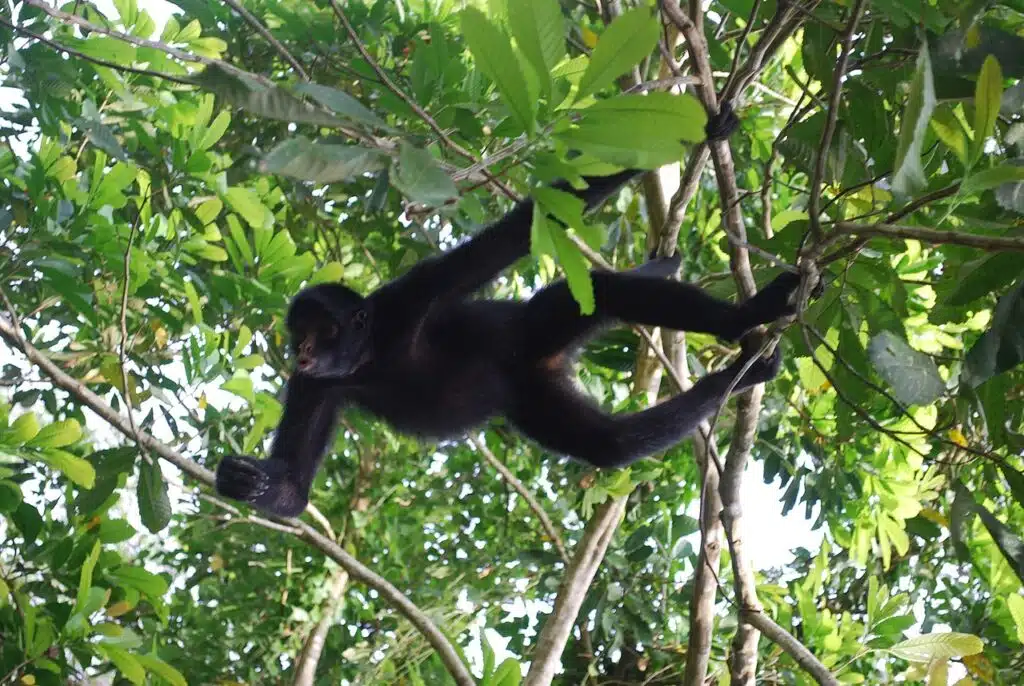
Black-faced Black Spider Monkeys (Ateles chamek) are some of the largest types of black monkeys in the world.
Growing to a size of up to 2 feet, these black monkeys also have mostly black faces.
Brazil, Peru, and Bolivia are the countries where the species lives.
Unlike other black monkeys, Black-faced Spider Monkeys can hang from their legs and hands which prompts their spider comparison.
These types of monkeys also have long black hairs and black feet similar to their hairy long tails which may be longer than 30 inches.
Living in social groups, they are known to have different communication means such as barking or different gestures.
Females of these groups feed more and are also known to live separately as they give birth to protect their offspring.
9. Grey-cheeked Mangabey
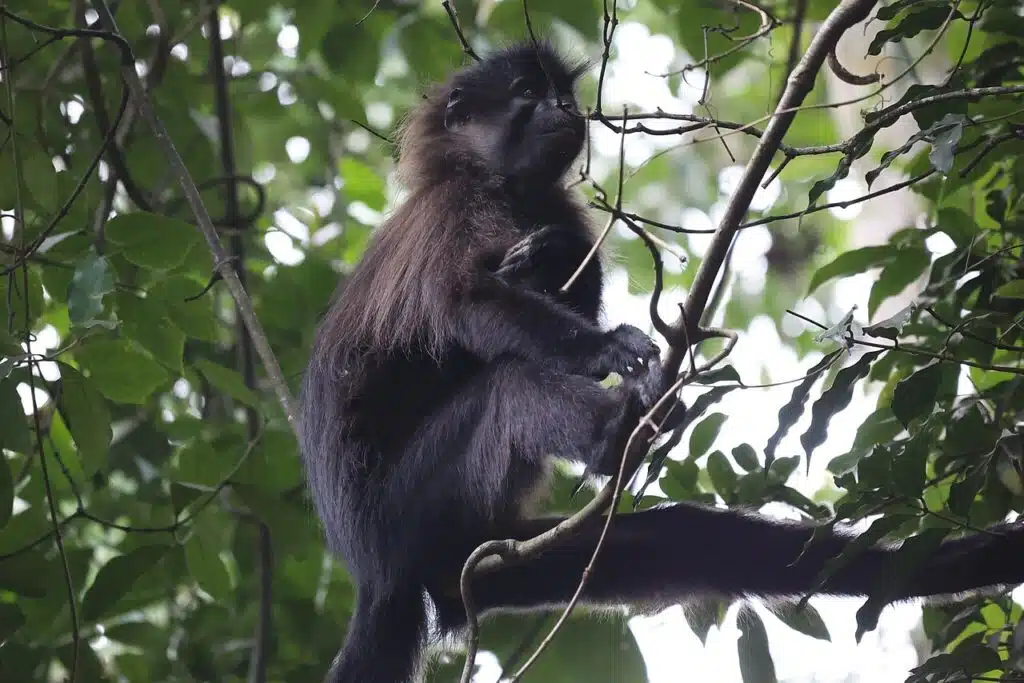
Some of the most aggressive types of black monkeys are The Grey-cheeked Mangabeys (Lophocebus albigena).
These Central African monkeys are known to fight a lot. Fights typically break out between males.
Mostly spending their time looking for fruit, they can eat nuts and seeds with their long teeth.
These types of monkeys maintain a black appearance throughout their life, both for males and females.
Long black hairs cover their body with gray hairs on the upper shoulders. They also show hairless black faces.
These large monkeys live in small groups which may sometimes count as many as 30 males and females.
There’s one dominant male in each group and the other males need to fight the alpha male for breeding rights.
Males of the species also use loud vocalizations to make others aware of their presence.
10. Celebes Crested Macaque
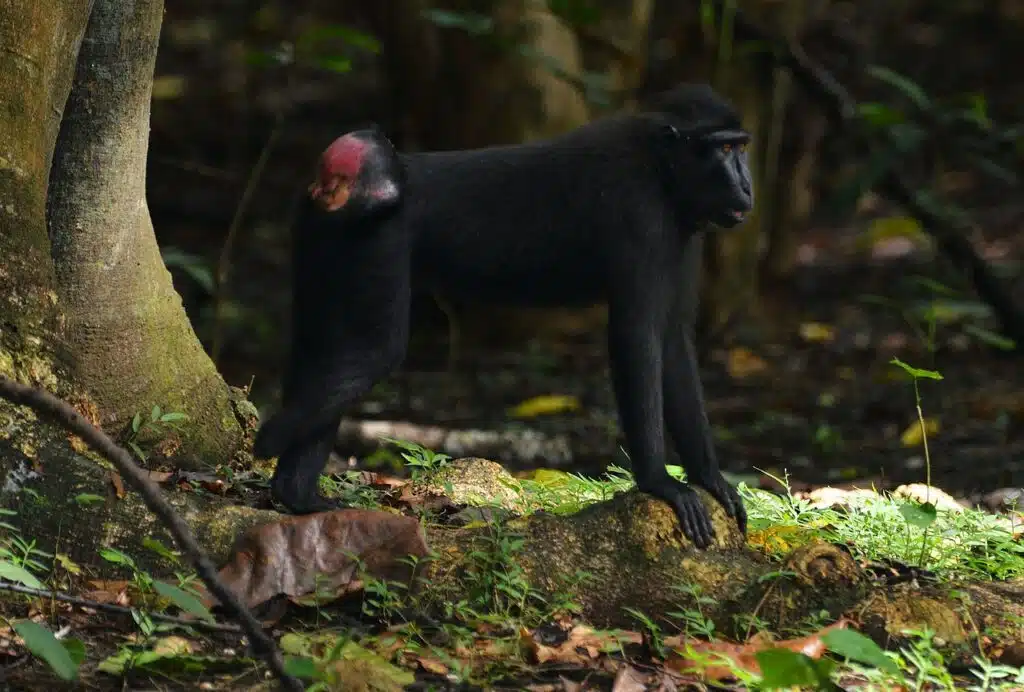
Celebs Crested Macaques (Macaca nigra) are all-black. They have a black body, black hands, legs, and a black face.
They even have a short black crest.
Native to Indonesia, this is a type of black monkey regarded as a pest to local crops and is often hunted by locals.
The species lives in groups where males and females breed among them.
Unlike many other types of black monkeys, Celebes Crested Macaques are mostly terrestrial.
While not entirely terrestrial, they spend much of the day on the ground, looking for food or spending time with other monkeys.
They eat fruit, leaves, and other foods that can be easily picked up.
While popular, these types of monkeys face an uncertain future as their numbers are diminishing.
11. Buffy-tufted-ear Marmoset
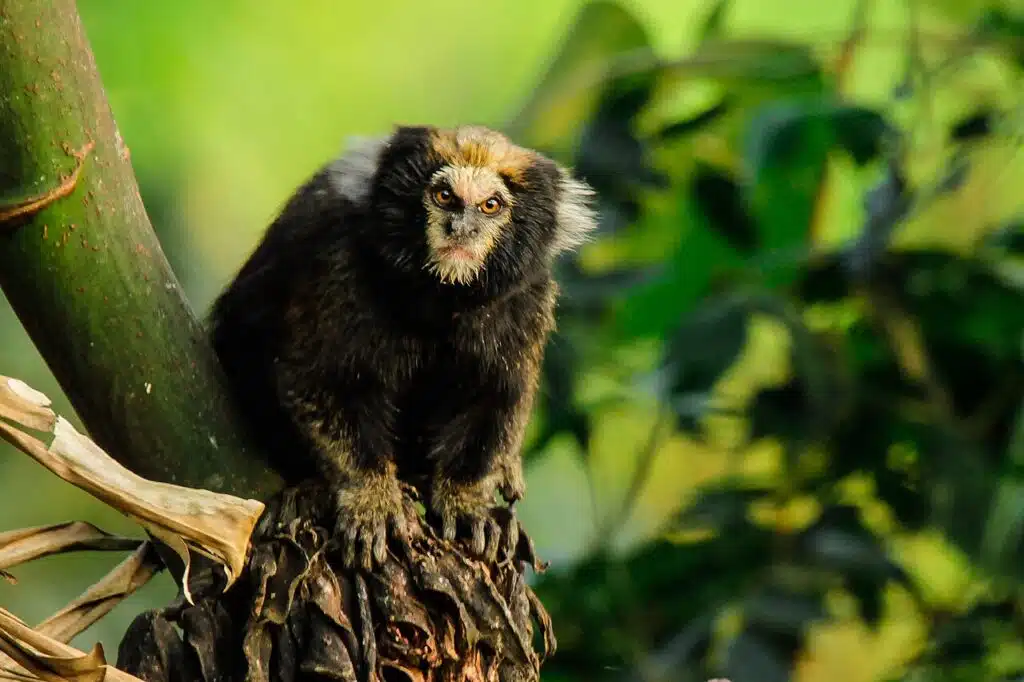
An atypical appearance and atypical behavior is what Buffy-tufted-ear Marmosets (Callithrix aurita) are known for.
Mostly black, these monkeys also have white years and brown crowns. Their white faces are hairy.
Unlike many types of monkeys, they are also known for mostly eating insects.
These monkeys live all of their lives up on trees in the remote forests of Southeastern Brazil.
However, they suffer in terms of habitat destruction as most of their native range is now gone.
This arboreal species is known for living up to 30 years in captivity but most live up to 13 years in the wilderness.
A diurnal species, they are mostly preoccupied with feeding and this is the first thing they do as soon as they get up in the morning.
12. Banded Surili
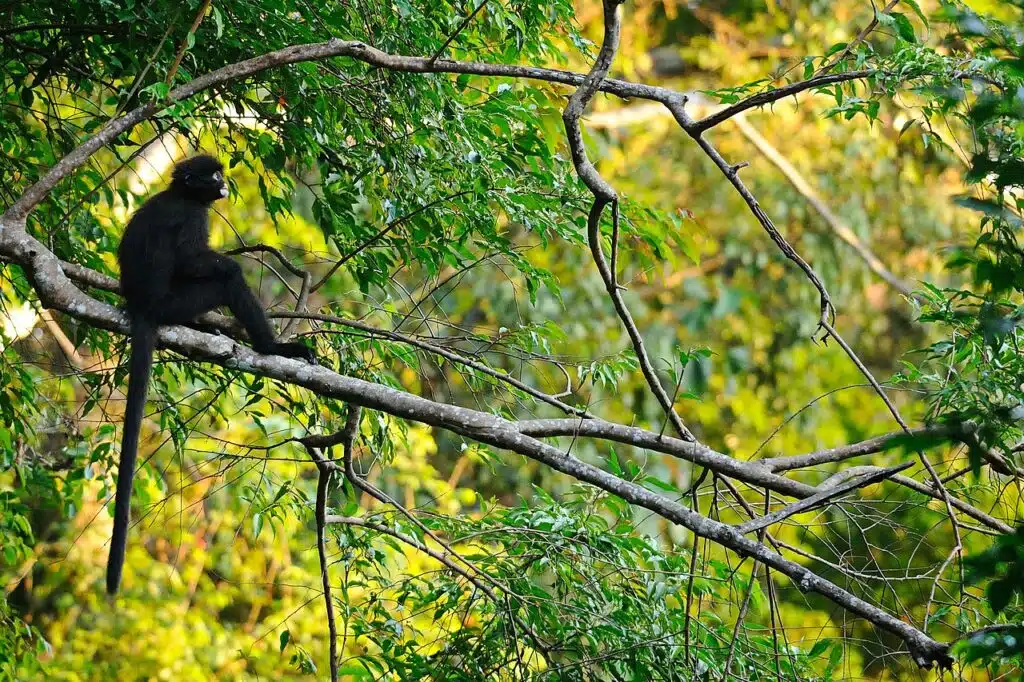
A mostly black species, Banded Surilis (Presbytis femoralis) are types of monkeys with short black hairs and contrasting white faces.
The regions around its eyes and mouth are bright, while the rest of its head, including the crown, is black.
A rather small species, Banded Surili monkeys grow to a size of just 24 inches, some being even smaller than 20 inches, particularly in the case of females.
Their tails are also long, sometimes longer than the body itself. Measuring up to 30+ inches, their tails are also hairy and black.
All of its 4 legs are used for walking in its natural habitat. This is a species endemic to forests with a spreading habitat to nearby plantations.
13. Javan Lutung
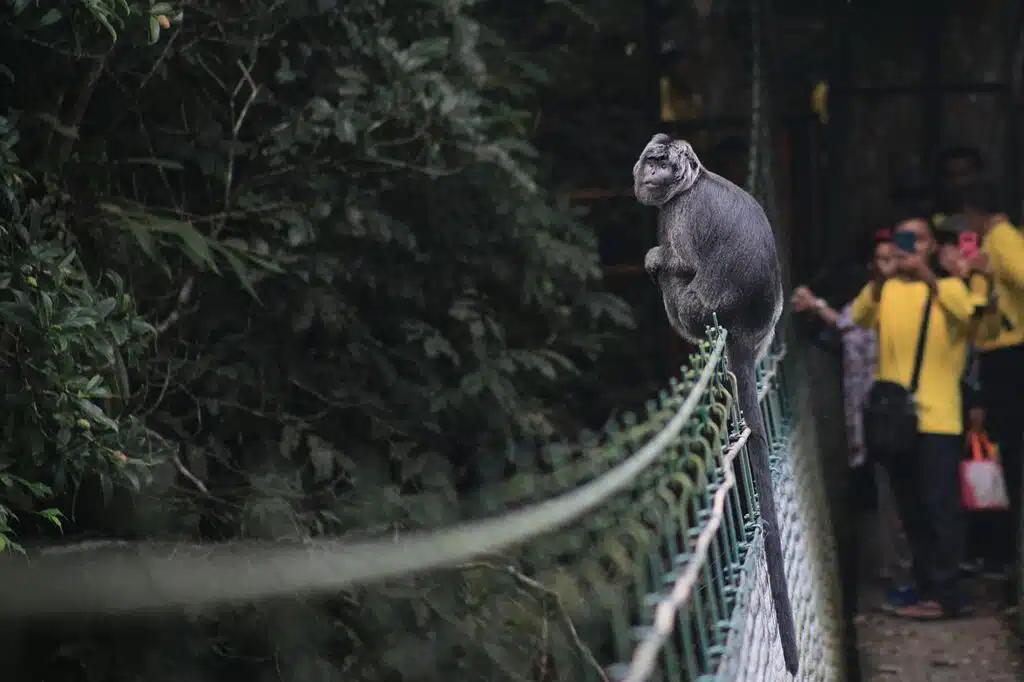
Glossy black hairs cover the Javan Lutung (Trachypithecus auratus). Native to Indonesia, this type of monkey is primarily found in higher elevation forests, on actual volcanoes, thousands of feet high.
They prefer to live in dense forests where they move from branch to branch with their black hands and legs.
Javan Lutungs also exhibit glossy black tails which show long hairs similar to those on the body.
These types of monkeys also have dark hairless faces which are either dark gray or black.
Some monkeys of the species may also show additional brown sections and brown hairs.
Now a species with an uncertain future, many of these monkeys end up being captured for illegal trade.
14. Miller’s Saki
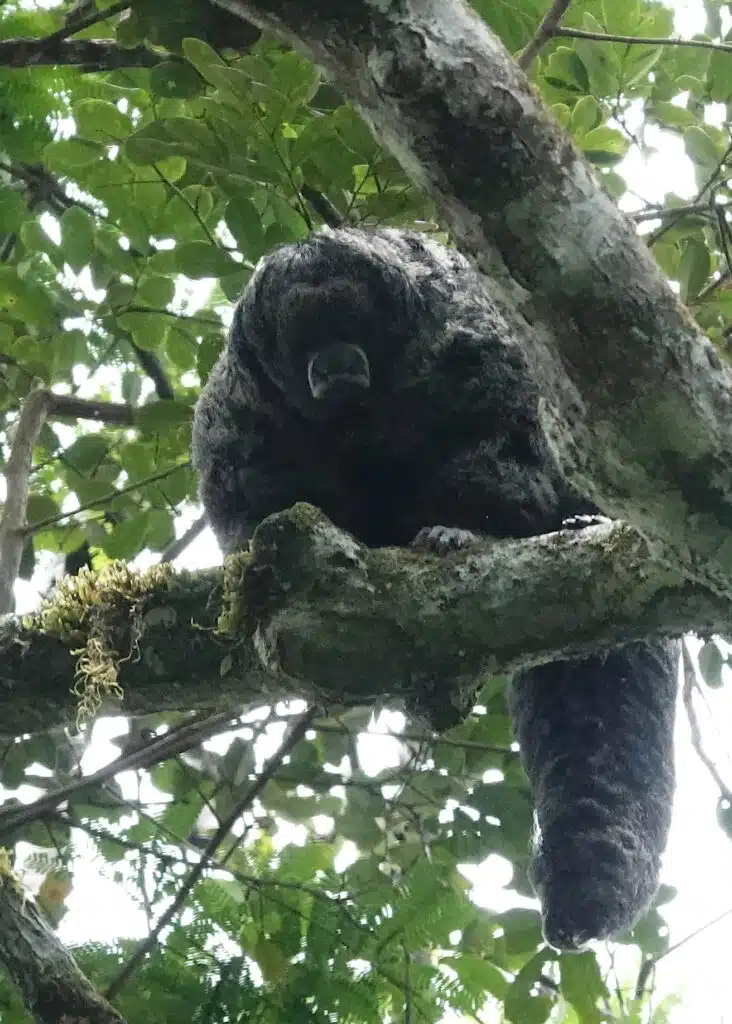
Not all black monkeys have similar hair length. Some have shorter hair while others have darker hair.
Miller’s Sakis (Pithecia milleri) are among the black monkeys with coarse long black hair.
These types of monkeys show additional brown hairs but have a mostly black face with white or cream contouring sections around the eyes and the mouth.
Small differences exist in the appearance of males and females. The female Miller’s Saki is slightly brighter, but this is only visible in the nuance of the face.
Miller’s Saki are also monkeys with a few brown hairs on the legs and hands, slightly more numerous on males.
These types of monkeys are South American natives, living in regions of Colombia, Ecuador, and Peru.
15. Black-shanked Douc Langur
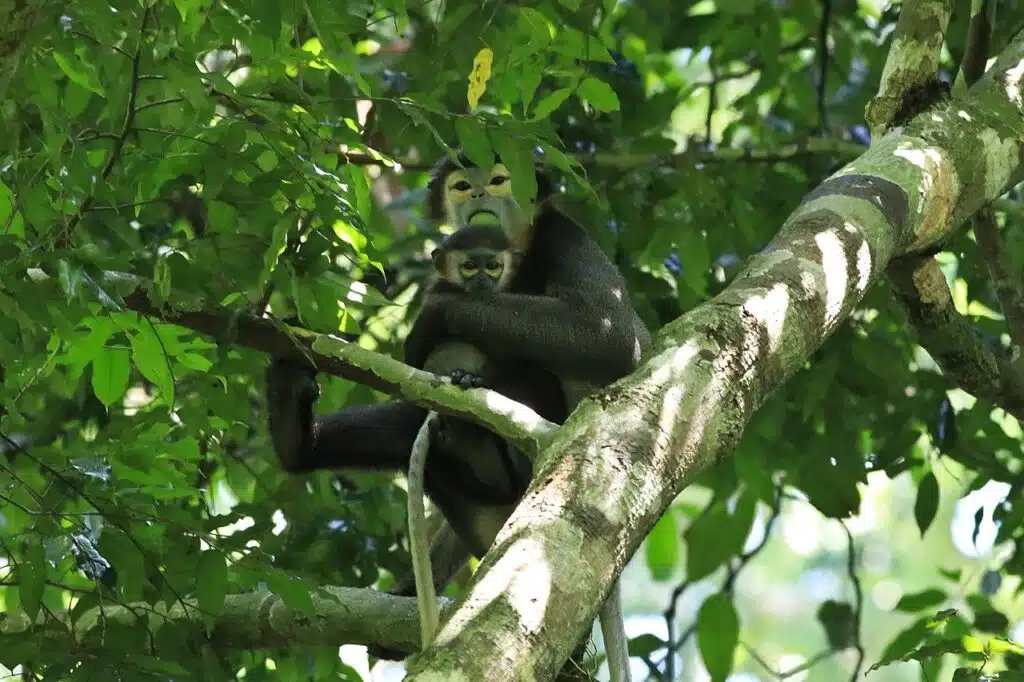
Parts of Vietnam and Cambodia are home to The Black-Shanked Douc Langur (Pygathrix nigripes), one of the most hunted types of monkeys in Southeast Asia.
Black is specific to most areas of the body of these multicolored monkeys.
Significant gray or silver sections further contrast their appearance on the chest and belly while their hands are also partly gray.
Gray and yellow sections are further distinguished on their faces.
Yellow-orange sections in the form of a band across its eyes add contrast to their faces.
Black-shanked Douc Langurs are now critically endangered with just a few thousand surviving in their natural habitat.
Smaller and smaller populations mean these monkeys now have a genetically impacted heritage as they breed among family members.
16. Putty-nosed Monkey
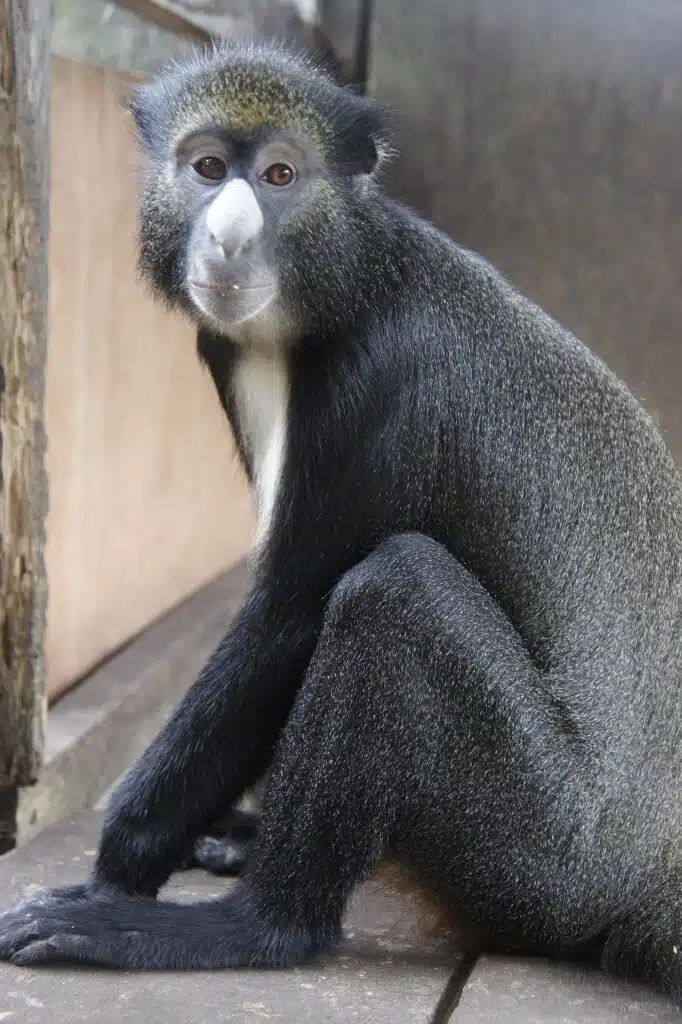
One of the most atypical types of black monkeys of the world has a contrasting white noise, as do Putty-nosed Monkeys (Cercopithecus nictitans).
This is a species with a black coat additional white and gray hairs and a matching mostly black head.
White and flattened noses are mostly specific to the monkeys which have bright gray hairless mouth areas and large brown eyes.
They still live in the wilderness in areas of West Africa in the forest or between forests and savannahs.
Often living with other species, these monkeys are known to create vocalizations that are communicated to other species of monkeys.
Seen up on trees, they are distinguished from other species with their white noses and reduced size as they can be as small as 14-15 inches.
17. West Javan Langur
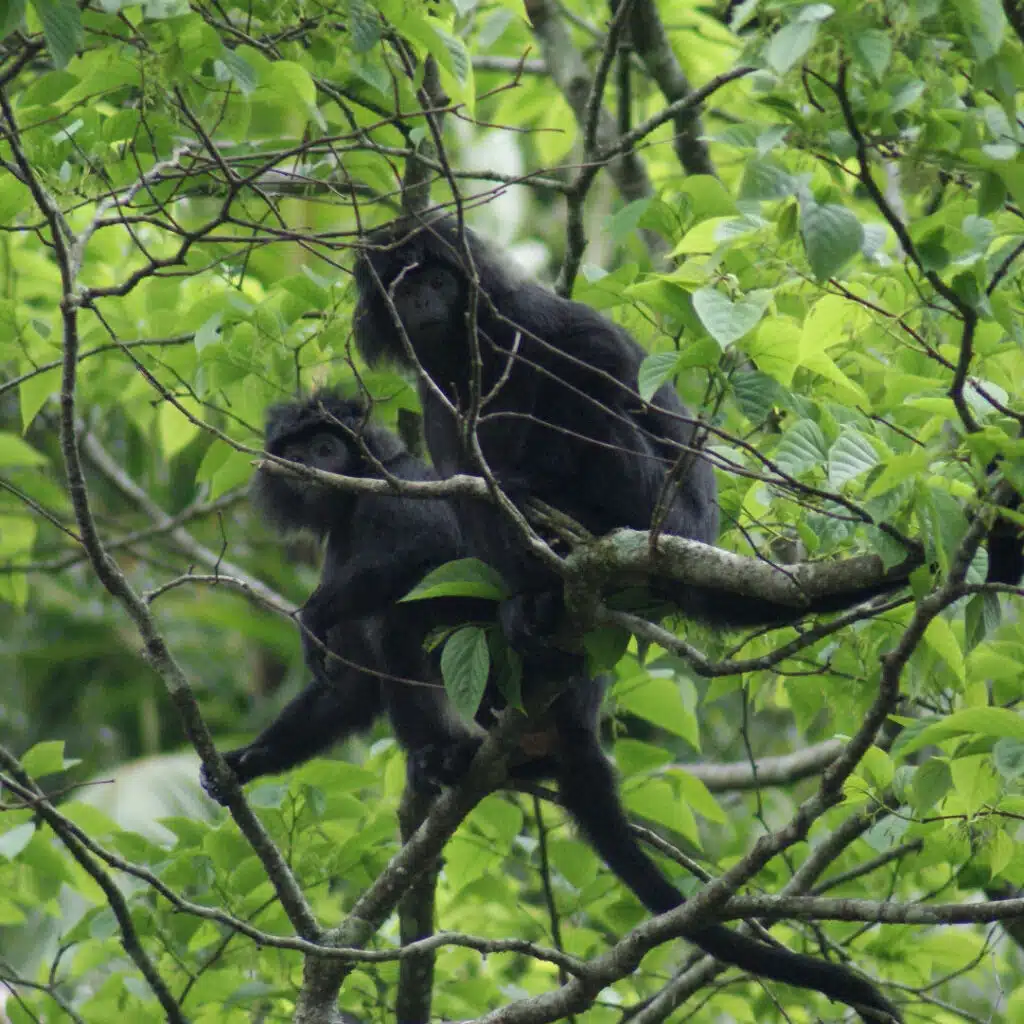
Mostly black and small, West Javan Langurs (Trachypithecus mauritius) additionally show gray hairs across their bodies.
The hairs on their small heads are also black, but typically longer than those on the body.
Mostly found in West Java, the monkeys aren’t always black as they become black with age.
Bright offspring are born bright brown and even orange.
The Indonesian species is often spotted caring for its bright young either by mothers alone or by all of the females in the group.
They grow to have an all-black appearance with a matching all-black hairless face while their young stand out with their brighter appearance.
Foliage represents their main food source as these monkeys can digest leaves and even eat the leaves other species cannot, living in considerable food abundance.
18. Golden-handed Tamarin
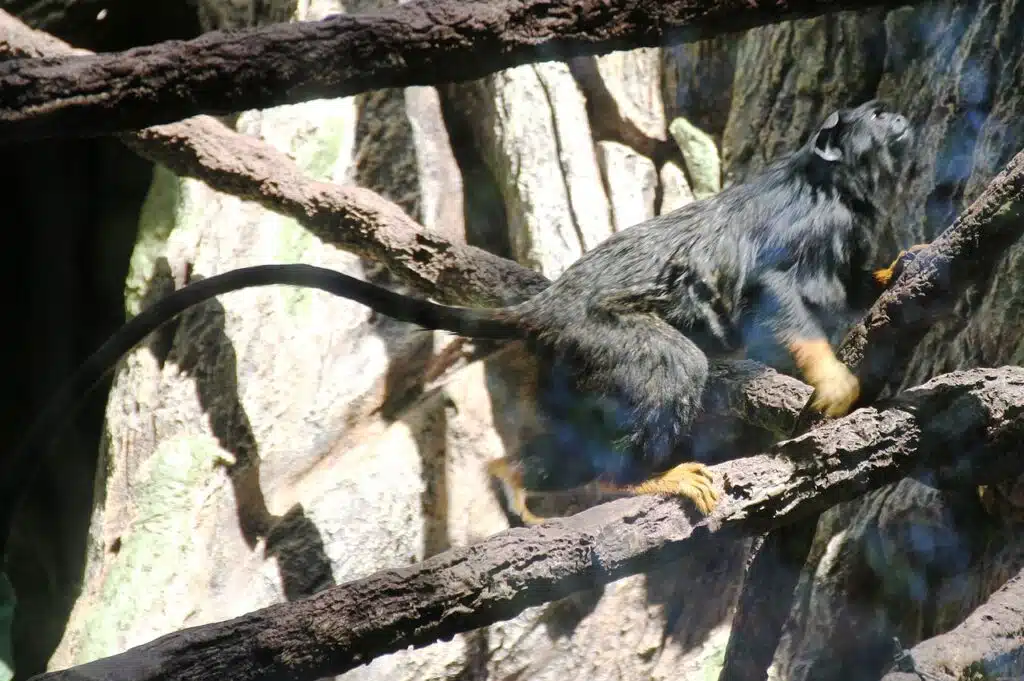
Golden-handed Tamarins (Saguinus midas) are named after their atypical golden-orange hands and feet.
The hands and feet of the species are in contrast to its mostly black appearance (sometimes dark brown).
Additional brown sections are seen across its back while its head and chest have a glossy black appearance.
Monkeys of this species are smaller, growing up to a size of 11 inches. Its tail may measure up to 6 inches as well.
As for the hairs on the body, the tail is also mostly black, with additional brown sections towards the base.
Apart from the vivid color of the legs and hands, Golden-handed Tamarins are also known for being agile and jumping long distances.
Unlike most other monkeys, they can leap from trees, similar to cats.
19. Brown-headed Spider Monkey
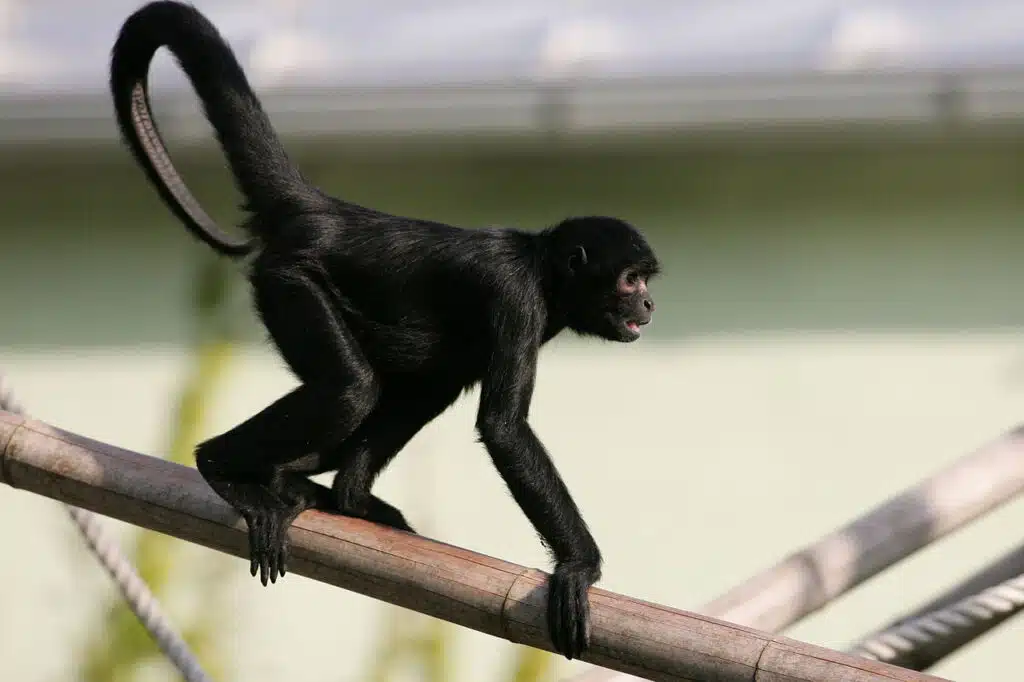
A mostly black appearance is specific to the Brown-headed Spider Monkey (Ateles fusciceps), a species with additional white or silver hairs across its body.
Its black hairs are long while its black and brown face is hairless. Its hands and feet are also black.
A Colombian native, The Brown-headed Spider Monkey is among the few species that live at different elevations, in the rainforest.
It can live in valleys or higher up at an elevation of up to 8,000 feet.
These monkeys have further adapted to the agricultural areas in their native range.
Known for their agility up on trees, these monkeys spend most of their days resting or looking for food such as various small fruits of the rainforest.
All types of other foods are considered tertiary nutritional sources and may include leaves or bark.
20. Phayre’s Leaf Monkey
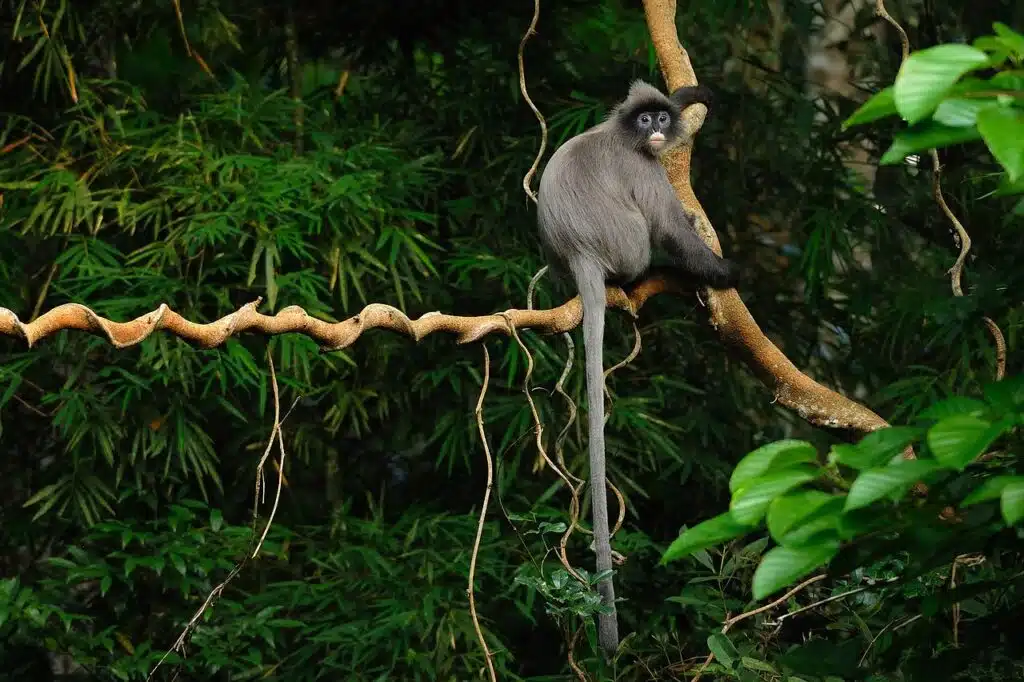
These types of monkeys (Trachypithecus phayrei) inhabit a vast area between Bangladesh and Thailand. They are mostly identified by the white sections around their mouths.
The hairs on their bodies are black and white. Mostly black, the monkey additionally shows white hairs on its dorsum as well as on its legs and feet.
This is a mostly arboreal species feeding on leaves.
Spotting it on the ground is a rare sight as Phayre’s Leaf Monkeys travel by trees alone.
They only come down when there’s no branch to grab onto to make it to another tree.
Monkeys of the species move trees in groups. A typical troop counts around 9-10 monkeys but larger and even smaller troops are known.
Only groups of up to 30 monkeys include more than one male as most groups are formed from a single male, females, and their juveniles.
21. Guiana Spider Monkey
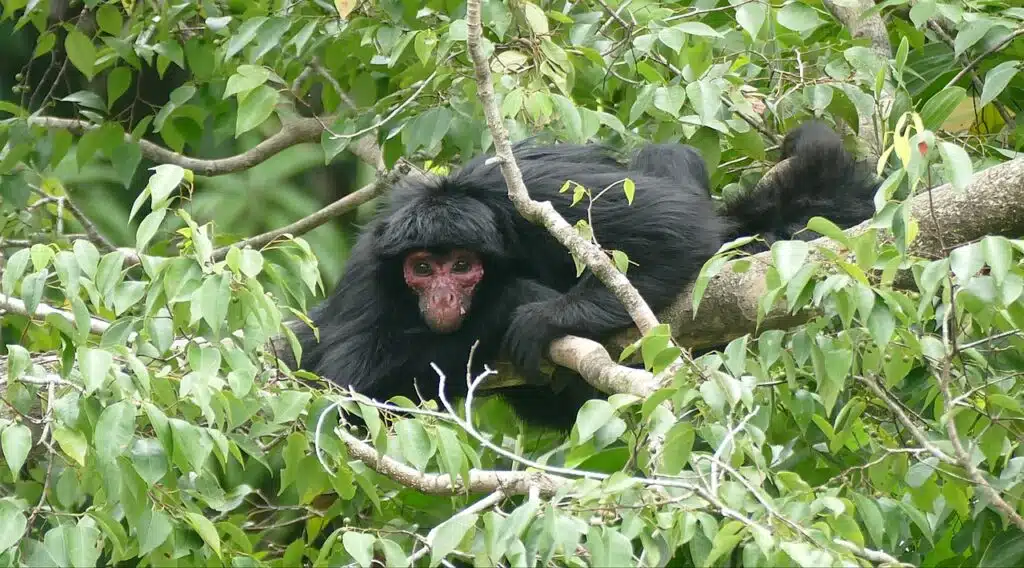
All-black hairs are specific to The Guiana Spider Monkey (Ateles paniscus). This is a species showing glossy black hairs that are long and cover the body, head, legs, and hands.
The face is pink to red and shows bare skin which contrasts the dark appearance of this species.
Guiana Spider Monkeys are agile, despite not having an opposing thumb. They do, on the other hand, have long fingers that are also strong.
They can hang off their fingers when reaching for their next ripe fruit.
Long and strong fingers often compared to hooks also help these monkeys swing branches.
Social behaviors include living in a group and even spreading into sub-groups for food during the day.
22. Red-nosed Bearded Saki
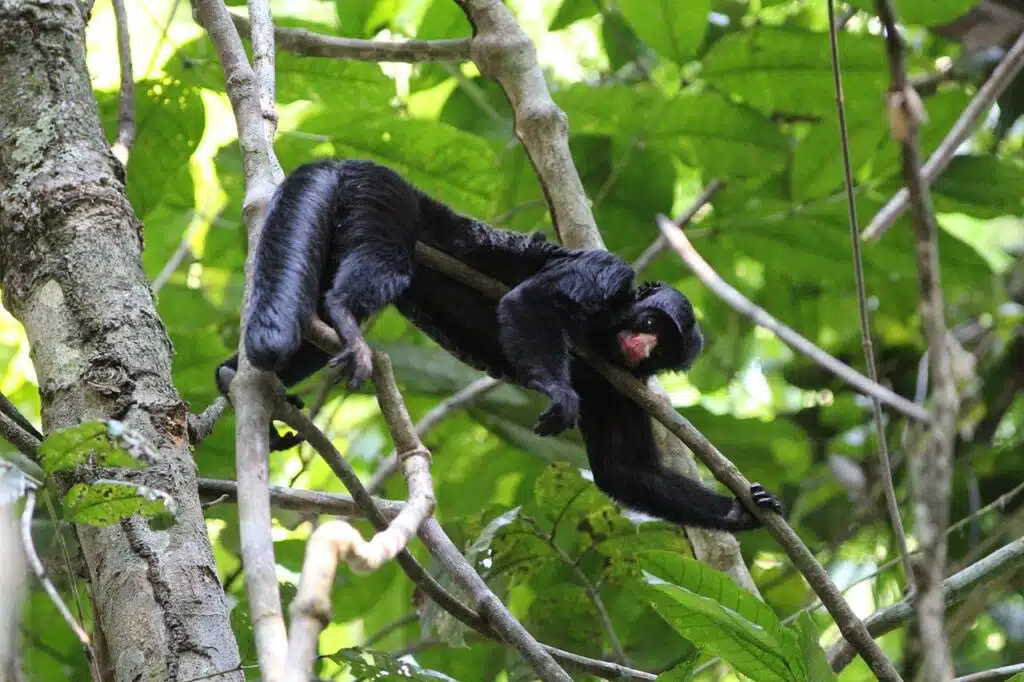
Living in the Northern Amazon, Red-nosed Bearded Sakis (Chiropotes albinasus) are all-black.
These monkeys live in one of the most protected areas of The Amazon in high numbers and are identified by their long black hairs forming a beard.
Long black hairs are also specific to the top of their hands.
Red-nosed Bearded Sakis are further known for their black hands and hairless black faces.
A glossy black primate, the species mostly feeds on fruit. Other food supplements include seeds, flowers, and small insects.
These monkeys live in social hierarchies and groups of up to 30 individuals.
While these groups are large, they spread into smaller groups when it comes to moving for food or looking for new food sources.
23. Black Lion Tamarin
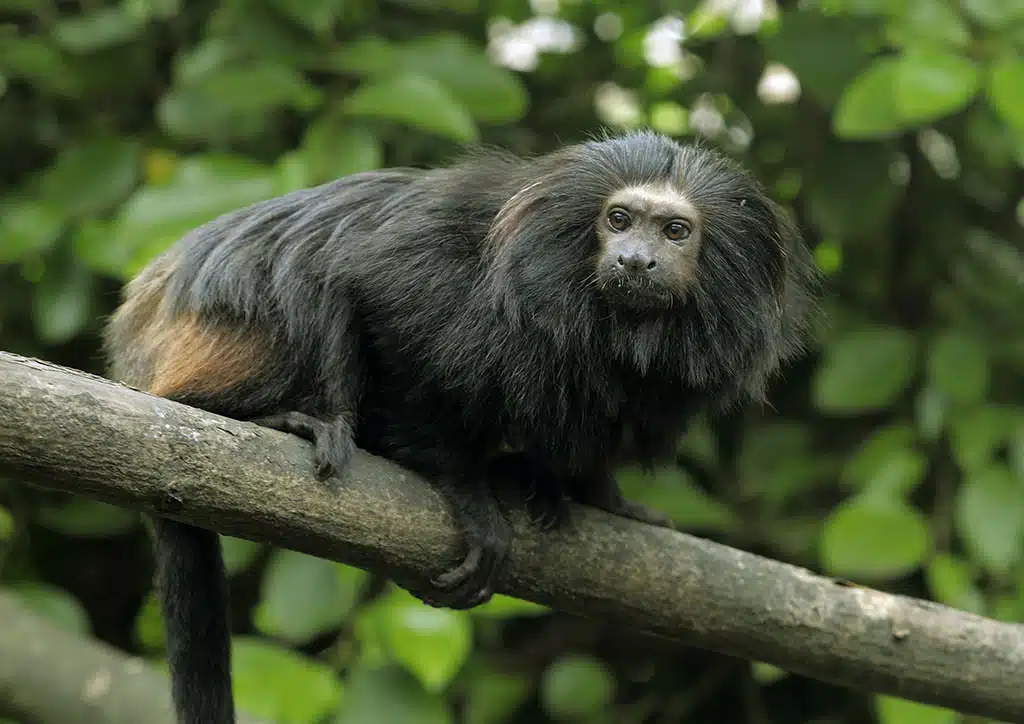
Black Lion Tamarins (Leontopithecus chrysopygus) live in the Southern Amazon, in areas where they’re less protected than Red-nosed Bearded Sakis in the Northern Amazon.
These small monkeys are predominantly black. They show additional brown sections at the base of their tails and on the forehead.
Long black tails are also specific to these monkeys which are even longer than their bodies.
These types of
tamarins are territorial establishing their habitat at least across 75 acres per social group.
This is a large area they forage in and an area they defend from other males and females that may want to infiltrate their group.
Facing a diminishing fragmented territory, this is a species that also shows vulnerability to predators.
It now has an endangered status but may still fall prey to snakes and other predators.
24. Moor Macaque
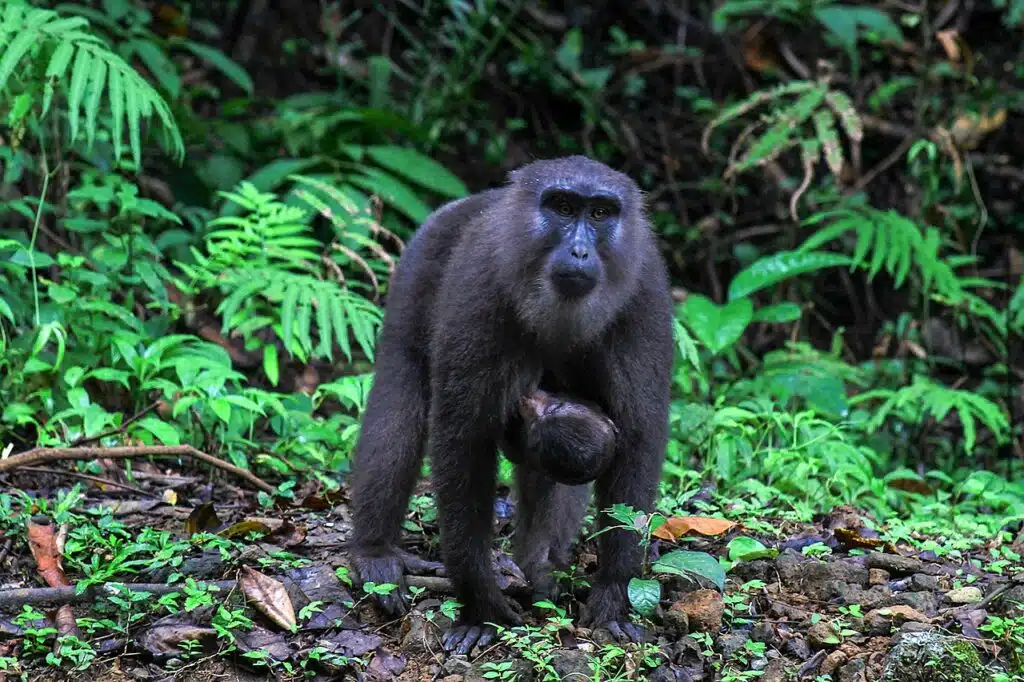
Native to Indonesia, Moor Macaques (Macaca maura) have a dark brown to black appearance. Their dark brown hairs also grow among black hairs, giving it a black appearance at first glance.
These macaques also have black hairless faces.
Spending their days on trees, they survive their island habitat by eating the fruits of the forests.
Living in small groups, they take control of an area sometimes as large as tens of acres which they maintain territoriality.
Troops of up to 45 individuals are specific to this species.
Up to 2 males are specific to smaller groups but females prefer to breed with the dominant male of the group first.
Some groups where there are more males generally tend to be peaceful due to a clear male hierarchy.
25. Spix’s Red-handed Howler Monkey
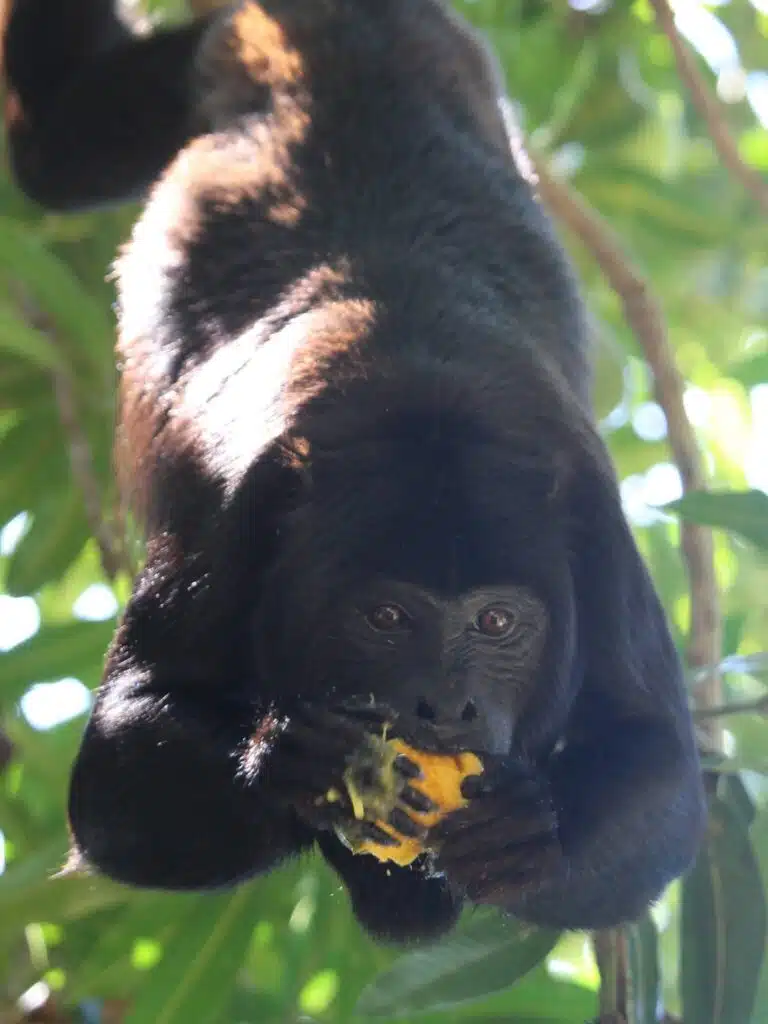
Mostly black, Spix’s Red-handed Howler Monkeys (Alouatta discolor) inhabit large territories in the Eastern Amazon.
These types of monkeys are mostly black and have long black beards but there are some degree of appearance differences depending on their location alone.
Black Spix’s Red-handed Howler Monkeys are common. Other coloring includes a monkey with red fingers or orange-red fingers as well as red hands, feet, tail, and genitalia.
All 3 variants are primarily glossy black.
These large monkeys mostly eat plants and leaves. While they do have certain preferences for the plants they eat, there are tens of documented species they are known to feed on.
High numbers of plants they eat are also specific to the vast territories they inhabit, from lowland forests to forests at several thousand feet.
They may move around the forest during the day but prefer to rest together on a smaller tree at night.
26. Red-handed Howler Monkey
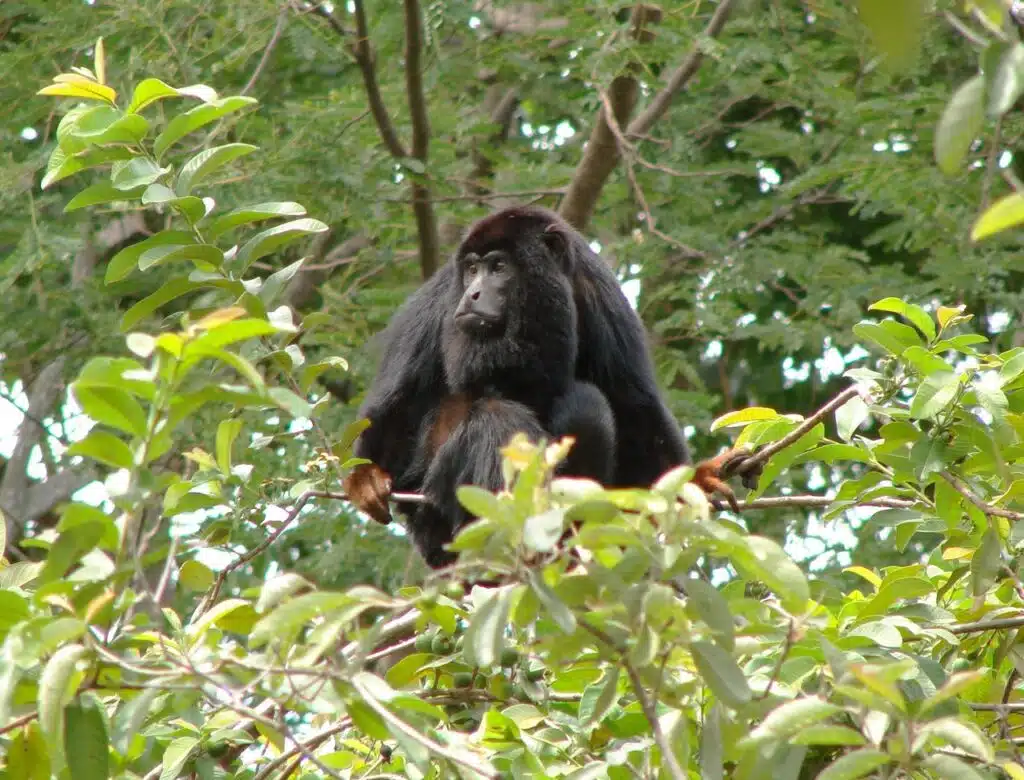
Howler monkeys are known for their loud vocalizations and their considerable presence in South America.
Among them, the Red-handed Howler Monkey (Alouatta belzebul) shows an almost completely black appearance.
It features long black hairs across its body as well as red-brown hands and legs.
These monkeys eat leaves and different types of plants. They have also been known to feed on specific types of soil for their added digestive benefits, on occasion.
Unlike a few other species, the monkeys can also feed on the older plant leaves, not just on the newer ones.
27. Robinson’s Banded Langur
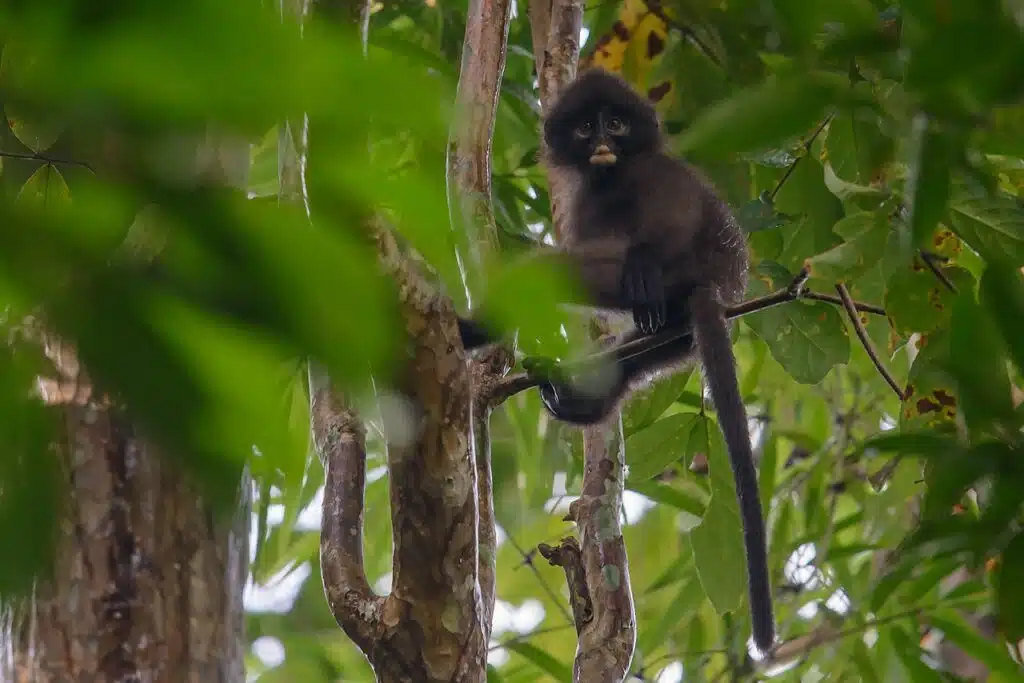
A species that reaches a maximum size of 24 inches, Robinson’s Banded Langurs (Presbytis robinsoni) are also black.
Black hairs cover their bodies while their hairless faces are also mostly black, with the exception of the white areas around the mouth.
These small and fast monkeys live most of their lives in upper canopies where they survive in groups.
Some of the larger groups count 9-11 individuals. Smaller groups of a male and 2 females with offspring are also possible.
These monkeys are mostly active in the early morning.
28. Lucifer Titi
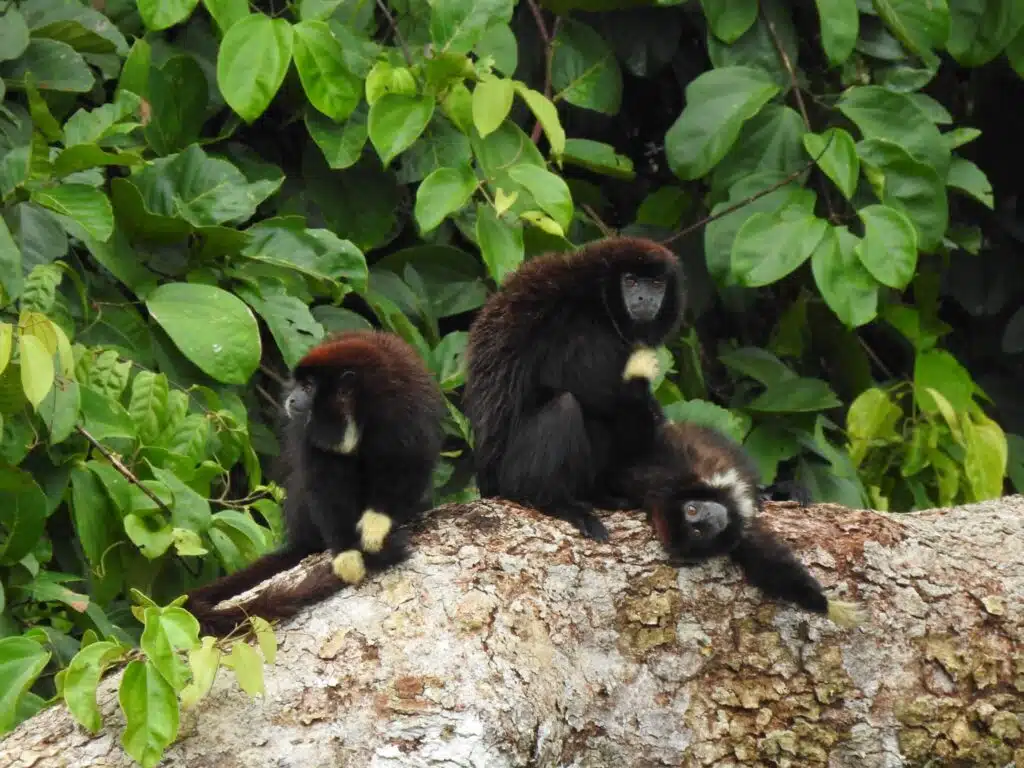
Lucifer Titi (Cheracebus lucifer) is the largest type of titi monkey in South America, reaching a maximum size of almost 20 inches.
These types of monkeys have a black nuance with red overlays and red caps. Their hairless faces are also black.
Yellow, white, or cream hands contrast the dark appearance of these monkeys.
Known for living lower down on trees, these monkeys are present in Brazil, Peru, and Ecuador.
They live in some of the smaller groups of monkeys. Even the largest social groups of the species only count up to 5 individuals.
29. Monk Saki
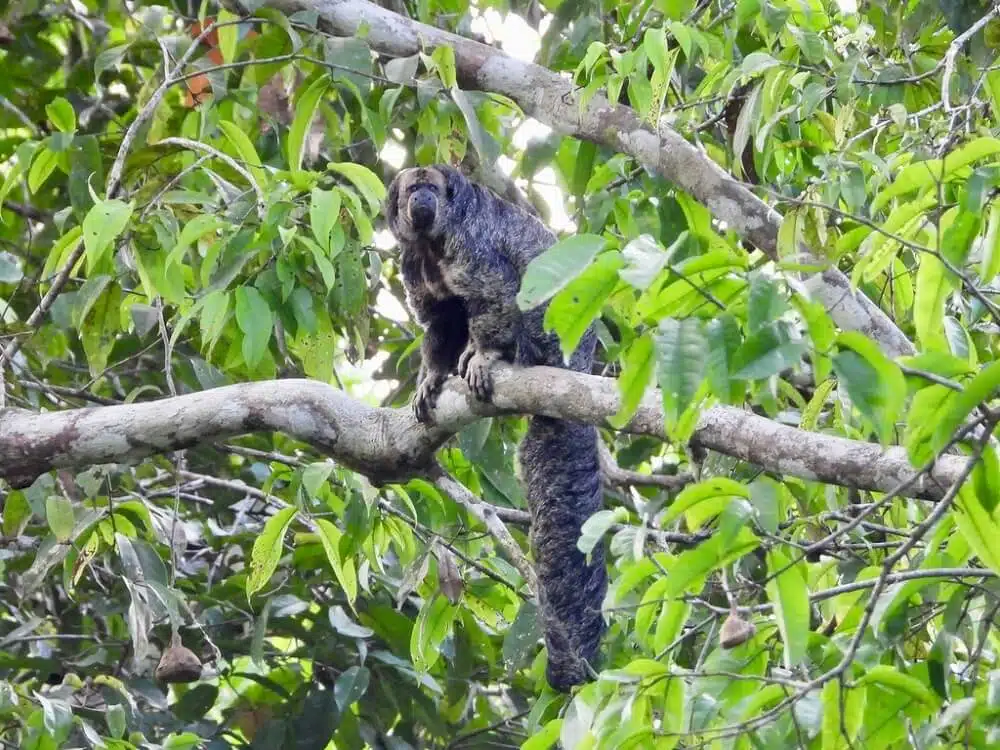
Gray-black hair covers the Monk Saki (Pithecia monachus). This hair is coarse and long, offering a ruffed appearance to these monkeys as opposed to glossy black hairs and their appearance otherwise.
The monkeys of the species are diurnal and arboreal. They feed on fruits and seeds and are native to South American forests.
Spotting these monkeys isn’t as easy as with other lower canopy species such as Lucifer Titi as they live in the higher canopy.
Known for their agile movements, these monkeys can leap on other nearby trees as they move for food with their groups.
Up to a third of the day is spent by the species either feeding or looking for food.
30. Black Titi
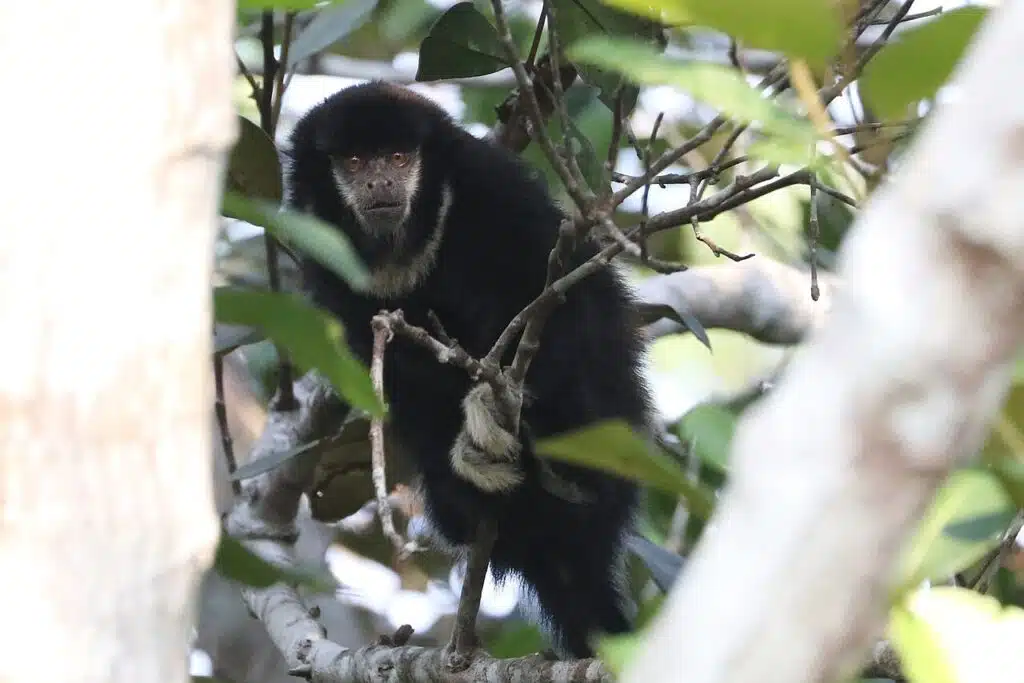
Almost completely black and partly white on the chest and neck, Black Titi Monkeys (Cheracebus lugens) are native to Colombia.
They are found in dense forests along a water source and are among the few monkeys to live in pairs or very small groups.
A male, female, and their offspring from a typical group. Males and females can also live in groups together, but only up until they form pairs and breed.
These monkeys show low levels of aggression within the group and high levels of territoriality towards other nearby groups.
31. Black-bearded Saki
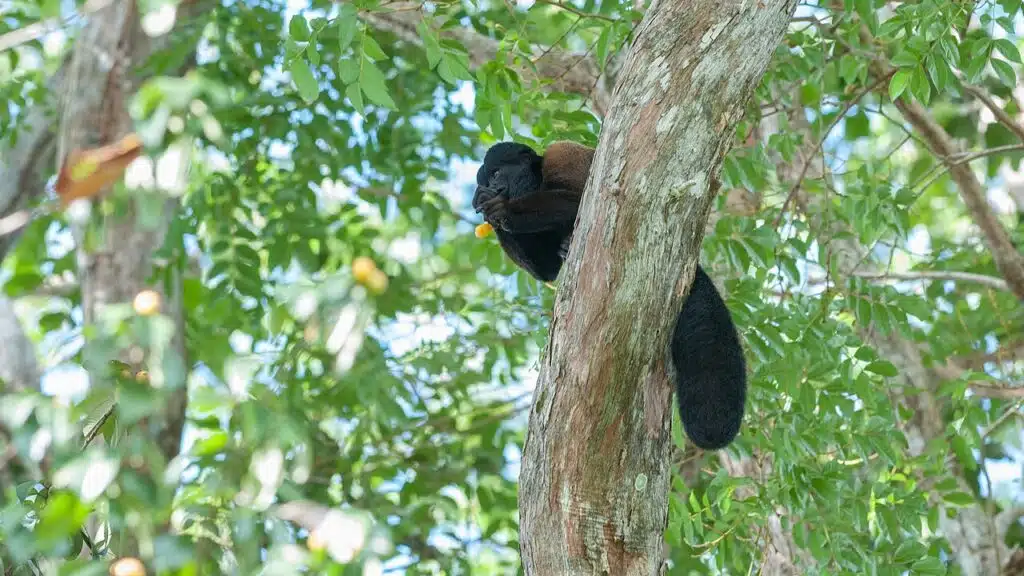
Some black monkeys are known to have similarly matching black tails.
While Black-bearded Sakis (Chiropotes satanas) have an all-black appearance, their black tails are atypically bushy.
These tails are fluffy and almost not specific to monkeys.
Walking on all fours, these monkeys spend their lives up on trees.
Eastern Amazon forests of Northeastern Brazil represent their small range. It’s here that the monkeys mostly live off fruit.
32. Amazon Black Howler Monkey
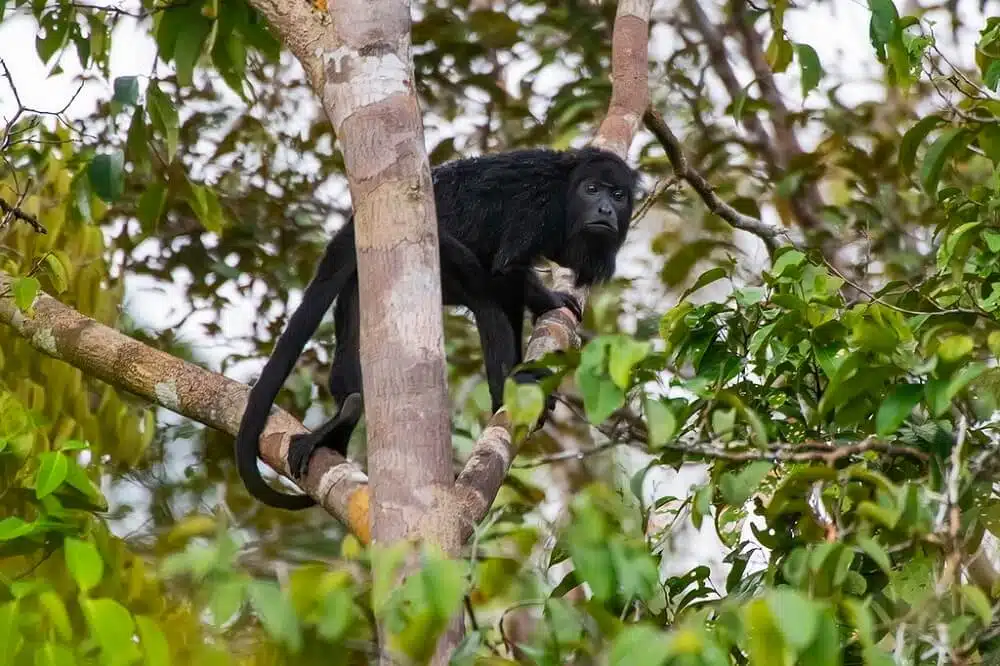
One of the most widespread species of The Amazon, the monkey (Alouatta nigerrima) is also one of the largest types of black monkeys in South America.
With a maximum size of up to 36 inches, these are some of the largest all-black and shiny monkeys.
Also displaying long black beards, these types of monkeys can howl loudly.
Their vocalizations are sometimes heard to a distance of 2-3 miles.
33. François’ Langur
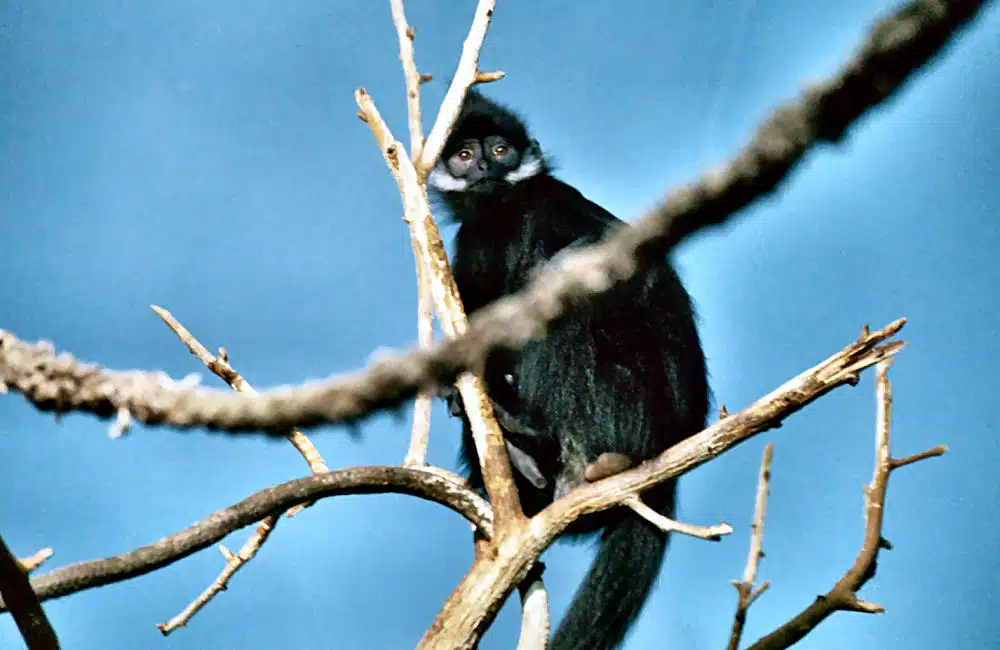
An almost completely black appearance describes these monkeys. They (Trachypithecus francoisi) also show atypical white sideburns which expand above the ears.
Limestone forests in steep areas are known as their atypical type of habitat. These types of soils are found in Vietnam and Southern China.
It’s here that the monkeys even enter limestone caves to hide in at night.
Mostly diurnal, they feed on old and new leaves of various species.
Living in small groups, these monkeys are dominated by an alpha male in their social hierarchies.